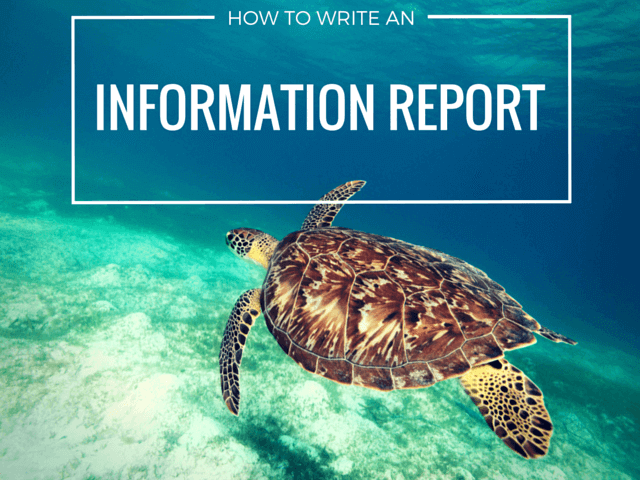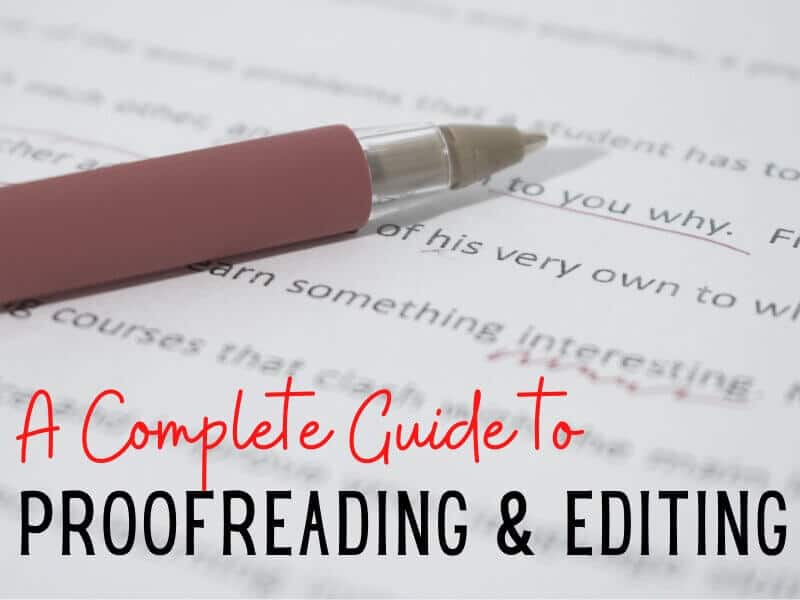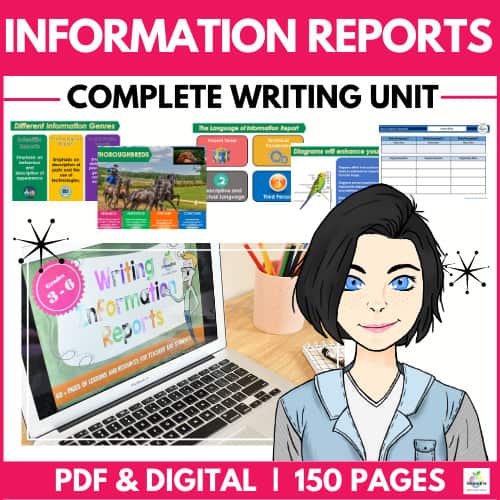

Informational text writing is an essential skill for our students to develop. Students will commonly encounter this text type in areas as diverse as technical, business, and scientific subjects across all years of schooling.
But Information report writing skills aren’t only useful in an academic context; they also have numerous applications beyond the school (or university) gates. They are used widely throughout various industries and professions, from construction to law.
Information Reports are usually short, concise documents that eschew arguments and opinions in favor of facts and objectivity. Often, informational texts bring interested readers and stakeholders up to speed on a given topic.
Whereas text types such as poetry and fiction writing demand a student’s creativity and imagination, writing informational texts requires students to possess some technical writing skills.
Fortunately, these skills can be taught and mastered with practice. This article will examine five critical skills and abilities required when writing information reports.
The Top 5 Informational Text Writing Skills
Informational Text Writing Skill 1: Thorough Research
“To be prepared is half the victory.”
Miguel Cervantes, Spanish Novelist
Preparation is a skill; thorough planning is required to ensure a well-written and soundly structured information report.
While it’s likely your students already understand the importance of the prewriting stage of producing an information report (or any text for that matter), it’s vital that they also learn to use their planning and preparation time as effectively as possible.
This means applying a rigorous and repeatable formula to the process. We can break the research process down into three key elements.

i. Break the Question Down
The research process begins with the student examining the writing prompt or question that instructs them to write an information report.
Students need to analyze the specific wording carefully, isolate the keywords and terms, and place these at the center of their research efforts by constantly referring back to them to avoid going off on irrelevant tangents.
Students should carefully respond to all parts of the report writing prompt. Often, there is more than one thing asked of them, and they must ensure they respond to each part of the prompt thoroughly in their completed information report.
ii. Define the Audience
The audience is a critical player in the report-writing process. Students must clearly define their report’s intended audience before going any further in the writing process.
Demographics play a key role in how an information report is structured and written. For example, a report about the life cycle of a frog aimed at an audience of first graders will differ wildly from a report on the same topic directed at zoologists.
Defining the target audience from the outset helps ensure students appropriately tailor their research, text organisation, and language register.
iii. Gather Research
Now, with a clear focus on their research efforts, it’s time for the student to gather up the necessary information for writing their report through online and/or print-based research.
While students must draw on various sources when writing their report, they also need to make sure that they evaluate the sources they use as they go.
Determining the reliability of the source is practically a science on its own, but some questions students should ask when evaluating sources for objectivity are:
- Who is the author?
- Who is the publisher?
- Is the content fact or opinion-based?
- Are the third-party sources and evidence used reliable?
Informational Text Writing Skill 2: Impeccable Planning
The whole purpose of an information report is to inform. It says so right there in the title!
To achieve this purpose, reports must be highly organized, and well-organized report results from impeccable planning.
The writing process is much more efficient when a report has been diligently planned. The writer avoids wasting time with irrelevancies, and identifying sources and keeping track of references is much easier. All this helps alleviate any stress placed on the student and makes for an overall better text at the end of the process.
A helpful way to organize the planning is by using themes marked by headings and subheadings that can later be used in the finished text.
Often, in reports, the opening provides a broad overview of the paper’s focus and gradually narrows it as it goes into more detail on various aspects or themes of the report’s topic.
There are all sorts of valuable tools to help facilitate the planning process, including:
- Brainstorming
- Mind maps
- Spidergrams
- Custom-purpose graphic organizers
It’s worthwhile spending the time necessary to ensure your students are familiarized with these and provide templates to help them practice these strategies. It will help facilitate an effective planning process for your budding report writers.
Informational Text Writing Skill 3: Coherent Writing
As mentioned, the purpose of this text type is to communicate information to the reader in a clear, easily understandable manner. To do this requires the student to consider a few things.
i. Use Appropriate Vocabulary
Firstly, they’ll need to write in a way appropriate for the audience they are trying to connect with. They will have identified this audience back in the research stage of writing, but they will now need to consider this information while writing.
Generally, it is good practice for students to avoid jargon in their information reports or, at least, introduce complex subject-specific vocabulary with a brief explanation when first mentioned in the text.
While the needless use of jargon should be discouraged, subject-specific vocabulary is unavoidable and should be encouraged. Where necessary, the student should consider including a glossary within their report to assist the reader in understanding difficult, unfamiliar terms.
ii. Use Straightforward Sentence Structures
For the same reason that they should avoid obscure and needlessly complicated vocabulary in their writing, students should also write in a straightforward and easy-to-understand manner.
The most efficient way to inform the reader is to communicate directly and uncomplicatedly. Students should not try to dazzle the reader with the beauty of sophisticated, grammatically complex sentences.
The purpose is to communicate information, not beguile with linguistic virtuosity. Reinforce with your students the importance of a no-nonsense approach to writing their information reports – the practical over the ornate, consistently!
One particularly useful strategy to help students write directly is encouraging them to picture a single individual they are writing the information report for.
This individual can be entirely imaginary, e.g. a hypothetical work colleague or boss, but having a clear image of the reader in their mind often helps the student to write in a more direct, straightforward manner.
Informational Text Writing Skill 4: Fitting Visuals
Visuals often accompany the text in information reports in the form of diagrams, charts, graphs, illustrations, and photographs. This serves three purposes:
- To add more detail and supplement the information contained in the text;
- To offer the reader an alternative method of ‘reading’ important information; and
- To illustrate concepts that are difficult to express in text form.
A capable student will not only skillfully select appropriate information to communicate visually but will also develop the skills necessary to present information in a visual form.
Luckily, there are lots of online tools students can use to help. Many of these are intuitive to use and can be learned quickly, with Canva being one of the most popular.
Google docs also offer many easy-to-use tools and add-ons, such as Google Drawing and Lucidcharts.
Informational Text Writing Skill 5: Excellence in Editing

For many students, editing is more of an afterthought than a distinct skill and an integral part of the writing process.
As with any complex skill, editing can be broken down into sub-skills that students will need to develop to ensure they achieve excellence in editing.
The editing process can helpfully be broken down as follows:
Step 1: The Structural Edit
Once the student has completed their draft, it’s time to undertake a structural edit. As you might imagine, this run-through focuses on the critical elements of the report’s structure.
This involves an examination of the overall organization of the text. This is a big-picture edit that assesses whether the report accomplishes the report’s original goals.
To help students ascertain whether or not their report is sound in structure and addresses the topic, they may ask questions such as
- Is the information within the report presented logically and coherently?
- Does the report answer the central questions investigated?
- Is all the information included relevant?
- Do the paragraphs flow consistently?
- Is the text formatted effectively?
- Are transitions between the different sections of the report effective?
- Are the tone and the style consistent throughout?
- Are the visual resources used appropriate and effective?
- Has spacing been used to good effect?
While the above questions help the student to focus on tangible aspects of the information report’s structure, the student should also consider less pin-downable aspects of their work, such as the ‘look’ and the ‘feel’ of the text.
Step 2: The Line Edit
In the next run-through, the student will narrow their focus down to each sentence to focus on grammar, spelling, and punctuation. This edit examines the nuts and bolts of the writing process, and students should ask themselves the following questions as they edit:
- Is the vocabulary used suitable for the topic and audience?
- Have clichés and jargon been avoided?
- Is everything spelled correctly?
- Is punctuation used correctly?
- Are verb tenses correct?
- Are the sentences grammatically sound?
If the student has word-processed their report, they will most likely have access to grammar and spell checkers, and they should certainly take advantage of that fact.
However, they should also cast a critical eye over every word in their report themselves. While checkers are extremely useful tools to help ensure accuracy, they are far from infallible and cannot ‘check’ on the writer’s intent. At least not yet!
Step 3: Take a Break
Have you heard the expression ‘can’t see the wood for the trees? Well, that’s as true, if not more true, in editing as in anything else.
Students often lack the necessary perspective to adequately edit their work when pressed against deadlines and even the desire just to be done with it. And, because it isn’t always possible to get a qualified third party with the time or inclination to run a critical eye over their work, it’s important that students take the time to allow their work to rest.
Ideally, this ‘rest’ will be at least overnight. If that’s not possible, the student should allow a few hours break before casting a final, refreshed eye over their work before submitting it.
Allowing for this time and distance allows the student to reset and helps ensure fewer errors escape the eagle-eyed editor!
Step 4: Read Aloud
The student should be encouraged to read the text aloud on the final run-through.
When the student reads their work aloud, they are forced to read at a slower pace than they would if they were reading their work silently.
This slower pace encourages the student to pay more attention to the words on the page and provides a further opportunity to catch any mistakes as they listen to the words rather than merely read them.
In the Final Analysis
As your students develop the skills above, it’s vital to reinforce that information reports are short, concise documents written for a particular purpose and audience.
These two facts should reinforce every decision students make during the writing process. With these facts consistently in mind, it will be difficult for students to stray too far from the report’s original goals.
By practising the skills required to write informatively for a specific audience and for a particular purpose, students will develop the skills necessary to communicate effectively throughout their schooling and beyond into their working lives.


